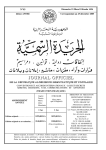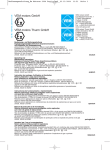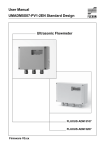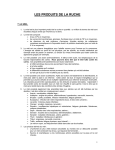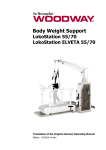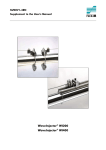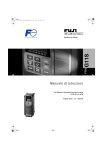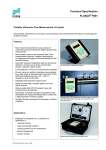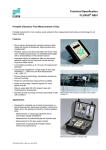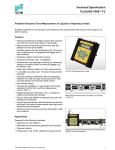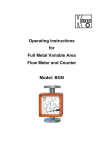Download Process Refractometer PIOX® R
Transcript
UMPIOXRV1-4EN User's Manual Process Refractometer PIOX® R Remark: PIOX® is a protected trademark of FLEXIM Flexible Industriemesstechnik GmbH. FLEXIM Flexible Industriemesstechnik GmbH Wolfener Straße 36 D-12681 Berlin Tel.: +49 (0)30 936 67 660 Fax: +49 (0)30 936 67 680 [email protected] www.flexim.de User's manual of the refractometer PIOX R300 Copyright (©) Flexim GmbH 2005 All rights reserved. Table of Contents 1 Introduction 1.1 Regarding this Manual 1.2 Safety Precautions / Handling 1.3 Suitability and Warranty 2 Description 2.1 2.2 2.3 2.4 3 Getting Started 3.1 3.2 3.3 3.4 3.5 4 First Control Manipulation Maintenance Cleaning Calibration of the refractometer Installation 4.1 4.2 4.3 4.4 4.5 4.6 5 Components of the Measuring System Measuring Principle Serial Number Firmware Version 3 3 3 3 5 5 5 7 7 9 9 9 9 9 10 11 Selection of the Measuring Point Connection of the Inline Unit Mounting the Electronic Unit Connection of the Inline Unit Connection of the Power Supply Connection of the Outputs 11 11 12 13 14 15 Operation of the Refractometer 17 5.1 5.2 5.3 5.4 Instrument Start-Up The Keyboard The Firmware Navigation in the Firmware UMPIOXRV1-4EN, 14/02/2005 6 17 17 19 19 7 Configuration of the Measurement 21 6.1 Selection of the Physical Quantity and of the Units 6.2 Correction Values 6.3 Other Values 21 22 23 Process Outputs 7.1 Enabling an Output 7.2 Output Range 7.3 Output Value in Case of Error 8 Serial Output 8.1 Definition of the Output Rate and of the Quantities to be Output 8.2 The Serial Output Table 8.3 Format Settings of the Serial Output 9 Output Options 9.1 9.2 9.3 9.4 9.5 Setting of the Damping Time Activation of the Process Inputs Activation of the Serial Output Status Output (Alarms) Activation of the Process Outputs 10 Starting the Measurement 10.1 10.2 Reset of the Status Outputs Protection against Interruption 25 25 26 27 31 31 33 35 37 37 37 37 38 41 43 44 44 A Technical Specifications 47 B Certificates 53 1 2 UMPIOXRV1-4EN, 14/02/2005 1 Introduction 1 Introduction 1.1 Regarding this Manual This manual has been written for the personnel operating the PIOX R300 refractometer. It contains very important information about the instrument, how to handle it correctly, how to avoid damaging it and how to avoid injury. Always keep this manual at hand. Get acquainted with the safety rules and the handling precautions. Make sure you have read and understood this manual before using the instrument. All reasonable effort has been made to ensure the correctness of the content of this manual. Should you however find some erroneous information, please inform us. Please note that we shall be grateful for any suggestions and comments regarding the PIOX R300 concept and your experience working with the instrument. This will ensure that we can further develop our products for the benefit of our customers and in the interest of technological progress. Furthermore, should you have any suggestions about improving the documentation and particularly this User's Manual, please let us know so that we can consider your comments for future reprints. We also provide special customer solutions and will be pleased to advise you in using PIOX R300 for specific applications and finding the most appropriate solution for your measurement problem. The technical specifications of the instrument as well as the content of this manual are subject to change without prior notice. All rights reserved. No part of this manual may be reproduced in any form without FLEXIM's written permission. 1.2 Safety Precautions / Handling You will find in this manual the following safety information: Note: The notes contain important information which help you use your instrument in an optimal way. This text gives you important instructions which should be respected in order to ensure the correct function of the instrument and avoid measurement errors. Read this text cautiously and respect the given instructions. This text gives you important instructions which should be respected in order to avoid injuries of the personnel or damages to the instrument. Proceed cautiously! Respect these safety precautions! 1.3 Suitability and Warranty You have bought a high quality measuring instrument. We thank you for trusting us. We take no responsibility whatsoever concerning the suitability of the PIOX R300 for a particular measuring tasks. It is the duty of the user to ensure that the refractometer is used only for the purpose for which it has been designed ("correct use"). The correct use of the instrument includes the respect of the mounting, commissioning and maintenance instructions. The user's manual and any complementary instructions you may have received with the instrument must be read before mounting, commissioning, operating or servicing the instrument. Improper installation and operation of the instrument can lead to the revocation of the guarantee. UMPIOXRV1-4EN, 14/02/2005 3 1 Introduction The PIOX R300 refractometer is guaranteed for the term and to the conditions specified in the sales contract provided it has been used for the purpose for which it has been designed and operated according to the instructions given in the present User's Manual. Misuse of the PIOX R300 will immediately revoke any warranty given or implied. This includes: • the replacement of a component by a component that was not authorized by FLEXIM, • unsuitable or insufficient maintenance, • repair of the PIOX R300 by unauthorized personnel. The manufacturer assumes no responsibility for damages resulting from incorrect use of the instrument. FLEXIM assumes no responsibility for injury to the customer or third persons proximately caused by the material owing to defects in the product which were not predictable or for any indirect damages. PIOX R300 is a very reliable instrument. It is manufactured under strict quality control, using modern production techniques. If installed correctly, in an appropriate location and as recommended, used cautiously and taken care of conscientiously, no troubles should appear. If any problem appears which cannot be solved with the help of this manual, please contact our sales office, giving a precise description of the problem. Don't forget to specify the model, serial number and firmware version of your instrument. 4 UMPIOXRV1-4EN, 14/02/2005 2 Description 2 Description 2.1 Components of the Measuring System The refractometer PIOX R300 is composed of an inline unit and an electronic unit which are connected together by a cable for power supply and signal transmission. Fig. 2.1: Inline unit PIOX R300 with electronic unit TR374 The inline unit contains the emitter (LED), the receiver (CCD) and the optical components: measuring prism (NP20 or DP20, fused quartz or sapphire), aperture and projection lens. It is also equipped with a Pt1000 temperature probe for the measurement of the process temperature. The inline unit can be mounted on the pipe with the usual standard connection systems. The electronic unit is composed of the signal processing system, the power supply, the operator interface and various interfaces for the communication with external devices. Its operator interface consists of a keyboard and a two-line display (16 digits per line). The keyboard features three function keys and 12 keys for numerical data input. A display of the refractive index, of the temperature-corrected refractive index, of the computed concentration and of the temperature is possible. 2.2 Measuring Principle The refractometer PIOX R300 measures the absolute value of the refractive index of liquids. The refractive index is a characteristic property of every material. It is defined as the ratio of the speed of light in vacuum to that in the material. The determination of the refractive index bases on the measurement of the deflection of a bundle of light rays having crossed the medium. The law of refraction, or Snell's law, describes the deflection of a light ray when crossing the interface between two different media: ni ⋅ sin θ i = nt ⋅ sin θ t with θ i the angle of incidence, θ t the angle of the transmitted light beam, n i the refractive index of the media in which the incident beam propagates, and n t the refractive index of the media in which the transmitted beam propagates. UMPIOXRV1-4EN, 14/02/2005 5 2 Description Medium Prism Light source b Fig. 2.2: Path of the light rays in the refractometer PIOX R Fig. 2.2 gives a schematic overview of the measurement as it takes place in the inline unit. The light emitting diode of the emitter unit generates a bundle of parallel monochromatic light rays. This bundle crosses the liquid to be measured and is deflected at the surface of a prism situated in the receiver unit. This deflection is amplified as the bundle is deflected a second time while leaving the prism. The deflected light rays create an optical image on a CCD cell situated in the receiver. The intensity maximum of this image is directly proportional to the deflection angle β. The CCD cell consists of a row of 2048 photo-detectors integrated in an electronic chip. It transforms the optical image into an electrical signal. With the help of a complex algorithm, this data is analyzed and the exact position of the maximum and thus the deflection angle is determined. The refraction index is then calculated basing on the law of refraction. The electronic unit receives from the CCD cell the signal giving the refraction index and the temperature of the medium. The results are displayed as configured by the user and the measured values and sensor values are transmitted to the outputs. 2.2.1 Concentration Measurement Refractive index n The refractive index is a characteristic property of every material. It the case of a solution, the index will vary with the concentration and the temperature. Fig. 2.3 gives an example of this interdependence between refractive index, concentration and temperature for a saccharoses solution. 1.5000 Temperature: 1.4500 20°C 50°C 80°C 1.4000 1.3500 10 20 30 40 50 60 70 80 Concentration (Brix) Fig. 2.3: Sound velocity in a saccharose solution as a function of the concentration If this specific curve is known and single valued in the working range, and if other influences on the refraction index can be excluded, it is possible to use the measured refractive index to determine the concentration or the density of the liquid. This is only possible in liquid two components system. This “calibration” procedure can be made at the Flexim laboratories or directly in the process. The dependence between the refractive index and the concentration is measured as a function of the temperature. It is then approximated as a polynomial of the 4th grade. The coefficients of this polynomial are recorded in the memory of the instrument and will be used to calculate the concentration on the basis of the measured refractive index. 6 UMPIOXRV1-4EN, 14/02/2005 2 Description The standard calibration curve of sugar (ICUMSA) is already recorded in the memory of the instrument . 2.2.2 Temperature Compensation For industrial applications, a temperature compensated refractive index or concentration value is often needed. The refractive index or concentration measured at the process temperature is corrected to an equivalent value at a reference temperature. The correction of the refractive index takes place automatically if temperature coefficients are stored for the medium. The reference temperature has been chosen when calculating the temperature coefficients of the medium and is an integral part of the coefficient record for the medium. 2.3 Serial Number Fig. 2.4: Data plate of the transmitter Fig. 2.5: Data plate of the inline unit The serial number of the electronic unit is indicated on the data plate on the side of the transmitter housing. The serial number of the inline unit is indicated on the data plate situated on the cable free arm of the unit. 2.4 Firmware Version Special Funct. Instrum. Inform. PXTR374-00999 v 1.10 01.10.04 UMPIOXRV1-4EN, 14/02/2005 Select SPECIAL FUNCTION \ INSTRUM. INFORM. to obtain information about the refractometer. Confirm with ENTER. The type designation and the serial number of your instrument are given on the first line. The firmware version and its date are given on the second line. Press ENTER to return to the SPECIAL FUNCTION program branch. 7 2 Description 8 UMPIOXRV1-4EN, 14/02/2005 3 Getting Started 3 Getting Started 3.1 First Control Upon delivery, control if every article you have ordered has been delivered. Please make sure that the specifications of the inline unit and of the electronic unit that were delivered correspond to the specifications given on the purchase order. Model designation and serial number are given on the data plate of the units. This instrument has already been tested thoroughly at the factory. When the instrument is delivered, please proceed to a visual control to make sure that no damage has occurred during transportation. 3.2 Manipulation Always manipulate the inline unit with care, it contains fragile optical elements. Never use the receiver and emitter arms of the inline unit for carrying! PIOX is a precision measuring instrument and must be handled with care. To obtain good measurement results and in order not to damage the instrument, it is important that great attention is paid to the instructions given in this User's Manual, and particularly to the following points: • Protect the instrument from excessive shock. • Manipulate the cables cautiously (avoid excessive cable bend). • Do not open the housing without authorization. The protective degree IP65 of the electronic unit PIOX TR374 is given only if the front plate is screwed on the housing. • Connect the flowmeter correctly to the power supply (voltage, frequency, connection to ground). • Make sure to work under correct ambient conditions (see specifications). Take the degree of protection into account. 3.3 Maintenance The refractometer PIOX R300 normally does not need regular servicing or maintenance work. Always respect the handling precautions and the instructions given in this manual. If PIOX is installed correctly, in an appropriate location and as recommended, used cautiously and taken care of conscientiously, no troubles should appear. Attention! 3.4 Never replace a component of the instrument by parts other than those supplied by Flexim. Cleaning Generally, the regular process cleaning and rinsing cycles are sufficient to keep the optical surfaces (prism and window) clean. However, depending on the nature of the liquid to be measured, it might be necessary to clean the measuring prism regularly to prevent the formation of deposits. When cleaning with a caustic soda lye or any other aggressive chemical, first make sure that all the joints and parts in contact with the medium are resistant. If a manual cleaning of the prism or of the window is necessary, this can be made with a small pipe cleaner or with a soft cloth. Only clean the prism with non-abrasive material! UMPIOXRV1-4EN, 14/02/2005 9 3 Getting Started 3.5 Calibration of the refractometer The refractometer PIOX R300 measures the absolute value of the refractive index. Normally, a calibration is not necessary. If necessary, proceed to calibration as described in section 6.2. 10 UMPIOXRV1-4EN, 14/02/2005 4 Installation 4 Installation 4.1 Selection of the Measuring Point The PIOX R300 inline unit is designed to be installed directly in the process line (mean stream). It should be installed at a measuring point which is representative for the process and relevant to the application. If the measurement is to be integrated in the process control system, make sure to measure at a location where a fast reaction to the measurement is possible. The following conditions must be fulfilled: • The inline unit should be mounted on a vertical pipe, with the medium flowing upward (rising pipe) to ensure that the prism is always flooded and rinsed. • The pipe must always be full. • The medium's pressure and temperature at the selected measuring point must lie within the specification of the inline unit. • Make sure that the ambient conditions are appropriate for the degree of protection of the inline unit and of the electronic unit. Do not isolate the units! If there is a risk that the temperature exceeds the specified temperature range, the units must be cooled. • The inline unit should not be exposed to direct sunlight or to rain or to vibrations (pumps!). • Select a measuring point where the medium temperature is as high as possible, but still respecting the temperature specification of the inline unit. The prism will keep clean better at high temperatures since the solubility is higher and the viscosity is lower. • Furthermore, there must be a minimum flow to ensure that the prism is rinsed. It is therefore recommended to select a location where the pipe diameter is relatively small and where the pressure is relatively high. This is particularly important if the mediums tends to form deposits or is transporting solid particles. • A certain amount of air bubbles in the medium does not influence the measurement but the prism must be flooded at any time. There will be less gas bubbles at a higher pressure since the solubility is then higher. • If the mediums is transporting solid particles, is highly viscous or abrasive, it is recommended to measure in a bypass which can easily be cleaned or to plan a possibility to discontinue the stream to clean the prism manually. It is also strongly recommended to integrate the refractometer in the cleaning process or to plan a rinsing circuit. • The selected measuring point should be easily accessible for service work. Select afterward the location of the electronic unit within cable reach of the measuring point. Make sure that the temperature at the selected location is within the operating temperature range of the electronic unit (see technical data in appendix A). 4.2 Connection of the Inline Unit Mount the inline unit on the pipe at the selected measuring point. If the inline unit is to be welded to the pipe, always make sure that that no welding beads or welding residues are left in the pipe before flooding the pipe and commissioning the refractometer. The beads and residues could damage the optical surfaces. Note: When mounting the sensor, make sure that the emitter and receiver units are aligned on another. A correct alignment is extremely important! Note: It is recommended to lay the cables from the measuring point to the instrument before proceeding to connection in order to avoid mechanical strain on the connectors. UMPIOXRV1-4EN, 14/02/2005 11 4 Installation 4.3 Mounting the Electronic Unit ø 3.5 35 25 4x ø6 30 ø8 200 163 Wall mounting with round head wood screw and plug M4 Mounting with M4 tallow-drop screw 265 280 70,50 Fig. 4.1: Mounting of PIOX TR374 200 163 M4 280 265 Fig. 4.2: Dimensions of the electronic unit PIOX TR207 (in mm) • Unscrew the front panel of the housing. • At the selected location, drill 4 holes in the wall according to Fig. 4.1. • Insert 4 plugs in the holes. Screw the housing on the wall. 12 UMPIOXRV1-4EN, 14/02/2005 4 Installation 4.3.1 Pipe Mounting Kit 3 2 1 8 4 5 7 6 Fig. 4.3: Pipe mounting kit for the electronic unit (1 = pipe plate, 2 = instrument plate, 3 = shackle) For pipes of approx. 2 inches in diameter: • Fasten the pipe plate on the pipe as illustrated in Fig. 4.3, then screw the flowmeter on the instrument plate with the supplied screw, washers and nuts. For bigger pipes: • For bigger pipes, it is possible to secure the pipe mounting kit to the pipe with tension straps threaded through the square holes of both plates instead of using the shackle. 4.4 Connection of the Inline Unit Attention! The protective degree of the refractometer is only guaranteed if all cables fit firmly and tightly in the cable glands, the cable glands are tightly screwed on the enclosures and the cover is tightly screwed on the housing. The connection of the inline unit to the junction box has already been made at the factory. The cable glands for the connection to the junction box and to the electronic unit were supplied with the refractometer. Prepare the connection cable and connect the leads of the connection cable to the terminals of the transmitter as specified in Table 4.1 and Table 4.2. Attention! It is important for a correct high frequency shielding that the cable shield has a good contact to the cable gland (and thus to the housing). UMPIOXRV1-4EN, 14/02/2005 13 4 Installation Table 4.1: Connection to the transmitter PIOX TR374 Terminal AV AVS ARS AR Lead yellow green brown white Table 4.2: Connection to the junction box Terminal + – A+ B- 4.5 Lead yellow green brown white Connection of the Power Supply An external safety switch must be installed in order to be able to interrupt the power supply of the refractometer rapidly at any time. The switch must be located near the refractometer. Use a switch with appropriate disconnection effect. Attention! The type of power supply needed for the instrument is indicated on the data plate situated under the power connection terminals. • Prepare the connection cable and connect the leads to the terminals of the electronic unit as indicated in Table 4.3. • Connect the other end of the power cable to the power supply. P7a KL3 L1 P6a F1 PE N P7b P6b P5a P7+ P7- P5b P5+ DC Terminal Connection PE Earth L- DC L+ + DC Fuse: 1.25 A, delayed action P6+ P4+ P5- P6- P2+ P3+ P3- P4- P1- P2- P1+ Table 4.3: Connection of the power supply AC Terminal Connection PE Earth N Neutral L1 Phase 100...230 VAC, 50/60 Hz Fuse: 1.25 A, delayed action POWER IN Fig. 4.4: Terminals of the electronic unit TR374 for the connection of the outputs and of the power supply 14 UMPIOXRV1-4EN, 14/02/2005 4 Installation 4.6 Connection of the Outputs The terminals to be used for the connection of the process outputs will be known only after the configuration of the outputs (chapter 7). The leads can be left unconnected for later connection if you don't configure the outputs now. • Prepare the output cable with a M20 cable gland. • TR374: Lead the output cable into the transmitter housing through the second filler plug on the right. The terminals P1 to P7 are intended for the connection of the outputs. Table 4.4: Circuits of the process outputs OUTPUT PIOX TERMINAL Current loop active Px+ (red) Current loop semi-active Px+ (red) used as active current loop Current loop semi-active Px+ (red) + Px+ (red) Current loop passive + (black) Px- Ri=500Ω Binary output + mA a Relays UMPIOXRV1-4EN, 14/02/2005 b Px+ Pxa (* RLOAD is the sum of all ohmic resistances in the circuit (resistance of the conductors, inner resistance of the auxiliary power supply, resistance of the ampere meter/voltmeter, etc.).) + UH + UH = 5 to 25 V - UH > 0.021A * RLOAD[Ω]+4V mA Example: If UH = 12V, then RLOAD must be between 0 Ω and 380 Ω ! + UH RLOAD > 2 MΩ (Note: With a smaller RLOAD, the precision will not be as high as specified.) V - UH = 5 to 24 V V - RC[kΩ] = UH / Ic [mA] RC + (black) Px- UH = 0 to 24 V UH > 0.021A * RLOAD[Ω] - + Px+ (red) OpenCollector (Reed-Contact) RLOAD < 50 Ω + + Px+ (red) Binary output mA (black) PxVoltage output RLOAD < 500 Ω mA (black) Px- - used as passive current loop - (black) Px- - + + (black) Px- - + CIRCUIT - UH Ic = 1 to 4 mA UMAX = 24 V IMAX = 150 mA Pxb Px- 15 4 Installation 4.6.1 Serial Interface RS232 TR374: The RS232 interface is located on the front panel of the instrument. 4.6.2 Serial Interface RS485 The electronic unit is also equipped with a RS485 interface. Connect the RS485 cable to the terminals A+ and B-, and the shield of the cable to the terminal 101. 16 UMPIOXRV1-4EN, 14/02/2005 5 Operation of the Refractometer 5 Operation of the Refractometer This chapter describes the user interface of PIOX R300. If you are already acquainted with these features, you can skip it and proceed to chapter 6 to configure the measurement. 5.1 Instrument Start-Up >PAR< mea opt sf Parameter Note! PIOX starts up as soon as it is connected to the power supply. The main menu is displayed after the initialization. No data can be entered while the serial number is displayed. 5.2 The Keyboard The operator interface of PIOX consists of a keyboard and a two-line display (16 digits per line). The keyboard features three function keys and 12 keys for numerical data input. NEXT 7 4 1 MUX 0 3x OFF BRK 8 5 2 DISP 9 Several keys have double functions. They can be used for INPUT as well as for SELECTION. 6 3 In SELECTION mode, for example, the arrow-shaped numerical keys operate as cursor keys. DISP LF LIGHT In INPUT mode, they can be used for the input of numbers and characters. ON C INIT ENTER RESET Fig. 5.5: The keyboard Table 5.1: General functions of the keyboard Switches the background lighting ON/OFF. LIGHT BRK INIT ENTER RESET BRK INIT Attention! ON RESET Press these keys simultaneously to recover from an error. This has the same effect as restarting the unit. Data will not be affected. INIT (cold start) Pressing these keys simultaneously and holding them down until the main menu appears will initialize PIOX. Some parameters and settings might be reset to the factory default values. After initialization, always check all parameters for correctness and control the configuration of the outputs. UMPIOXRV1-4EN, 14/02/2005 17 5 Operation of the Refractometer Be careful not to interrupt an ongoing measurement by inadvertently pressing BRK! Table 5.2: Selection BRK 4 8 Press on BRK to call the main menu. 6 Selecting the menu entry at the left or at the right of the currently highlighted one. 2 Scrolling upwards or downwards through the menus. ENTER Confirmation of the selected entry. Table 5.3: Input of numerical values DISP LF Input of the numerical value shown on the key Sign for the input of negative data Decimal point LIGHT Deletion of data. After the deletion of data, the previous value will be displayed. ENTER Confirmation of input. Table 5.4: Input of text 4 6 DISP Selection of the position of the character to be input. Changes the currently selected character to an 'A'. Changes the currently selected character to a 'Z'. DISP Changes between small and capital letters. 2 8 Moving to the next/previous ASCII character. Deleting the character currently shown and inserts a blank space. NEXT MUX ENTER 18 To automatically scroll upwards/downwards through the selected restricted ASCII character set. The character changes every second. The scrolling can be interrupted by pressing any other key. Finishes editing. UMPIOXRV1-4EN, 14/02/2005 5 Operation of the Refractometer 5.3 The Firmware 5.3.1 The Main Menu >PAR< mea opt sf Parameter After switching on and initialization, the main menu appears on the first line of the display. The main menu has following entries: PAR (parameter), MEA (measuring), OPT (output options) and SF (special functions), corresponding to the four main program branches. The actually selected program branch is displayed in capital letters between arrows. The full name of the program branch is displayed on the second line. Use keys 4 and 6 to select a program branch. Confirm your selection by pressing ENTER. 5.3.2 The Program Branches Table 5.5: Main functions of the different program branches PARAMETER: Selection of the measuring channel Selection of the measured medium, of the physical quantity to be measured and of the units Configuration of eventual correction parameters MEASURING: Starting the measurement Selection of the measuring point if many are defined OUTPUT OPTIONS: Setting of the damping of the measured values Activation of the process inputs and outputs Activation of the serial output Settings of the alarms SPECIAL FUNCTION: Settings of the process inputs and outputs Settings of the serial output (format, output rate and data to be output) Measurement settings Settings of the day and time Settings for the firmware dialogs Display of the serial number and of the firmware version 5.4 Navigation in the Firmware Parameter For Channel A: If a vertical arrow (Ú) is displayed beside a menu option, this menu option contains a selection list. This list is displayed on the second line. 2 Use the arrow keys 8 and to scroll through the list, then confirm your selection by pressing ENTER. I1 enable no >YES< UMPIOXRV1-4EN, 14/02/2005 PIOX sometimes requests a selection on the second line. The actually selected option is displayed in capital letters and between arrows. Use keys 4 and 6 to select one of the options, then confirm your selection by pressing ENTER. 19 5 Operation of the Refractometer Note: Note: 20 You can return to the main menu at any time by pressing key BRK. In this manual, all program entries and keys will appear in capital letters. Program entries are in typewriter characters ("PARAMETER"). Submenus are separated from the main menu entry by a backslash. UMPIOXRV1-4EN, 14/02/2005 6 Configuration of the Measurement 6 Configuration of the Measurement The measurement must now be configured, i.e. the quantity to be measured, the units and the correction values must be defined. The configuration must be made separately for every available measuring channel. It can be modified at any time later by calling the program branch PARAMETER again. >PAR< mea opt sf Parameter Parameter For Channel In the main menu, select the program branch PARAMETER and press ENTER. Select the channel for which you want to configure the measurement and press ENTER. A: A: Main measure Please setup... Note: This display does not appear if your instrument has only one measuring channel. This display will be shown only if the instrument was configured for the measurement of a three components solution. In this case, two physical values must be configured for the same channel. The configuration procedure must be gone through twice, once for the main physical value, once for the auxiliary value. Press ENTER to start the configuration of the main measurement. Proceed as described below. When you are through with the configuration, the following display will appear: A:Auxilary meas. Please setup... Press ENTER to start the configuration of the auxiliary measurement. The same configuration procedure is started for the auxiliary channel. Fluid Glucose Select in the fluid selection list the fluid to be measured. The fluid selection list contains standard fluid such as glucose, saccharose, etc., all fluids you have defined yourself and all fluids of the internal data base. If you want to measure a fluid which is not in the fluid selection list, select OTHER MEDIUM. Only scales will be available as physical quantities, since no coefficients are available for the medium. Confirm your selection by pressing ENTER. 6.1 Selection of the Physical Quantity and of the Units PIOX can measure the following quantities: • refractive index and normalized refractive index • concentration in mass percent • concentration in volume percent • Brix value UMPIOXRV1-4EN, 14/02/2005 21 6 Configuration of the Measurement The selected quantity will be displayed by PIOX during the measurement The normalized refractive index can always be displayed simultaneously. The normalized refractive index is a correction of the refractive index measured at the process temperature to the value of the refractive index at a given reference temperature. The correction of the refractive index takes place automatically if temperature coefficients are stored for the selected fluid. Measuring value Mass-Concentr. The physical quantities and scales available for the selected fluid are displayed. Physical quantities are for example the volume concentration and the mass concentration. The measurement of these quantities is possible only if the respective coefficients are available. A typical scale is for example the Brix value for the concentration of a sugar solution. Select the physical quantity to be measured. Confirm your selection by pressing ENTER. Unit of Measure % mas 6.2 If many units are available for the selected physical quantity, they are now displayed. This display does not appear when you have selected a scale. Confirm the units to be used. Confirm your selection by pressing ENTER. Correction Values The measured values can be corrected in two different ways. It is possible to correct the primary physical quantities measured by PIOX, which are the refractive index and the temperature of the fluid. These sensor values are corrected directly before they are used by the transmitter for the calculation of the selected physical quantities. It is also possible to correct the values calculated by the transmitter, i.e. the physical quantity you have selected and the normalized refractive index by adding a constant value. The corrections can be defined in the following displays. If you do not wish to define a correction, select NO in the two following displays and go to section 6.3. 6.2.1 Correction of the Physical Quantity and of the Normalized Refractive Index Measure adjusts? no >YES< Mass-Concentr.? no >YES< OFS:Mass-Concentr. 0.75 % mas If you do not wish to define an offset for the selected physical quantity or for the normalized refractive index, select NO, confirm by pressing ENTER and go to section 6.2.2. Otherwise, select YES and confirm by pressing ENTER. The selected physical quantity is displayed on the first line. Select YES to define an offset for this quantity. Confirm by pressing ENTER. Enter the offset. The unit displayed is the unit previously selected. The maximum possible value for the offset is 10% of the valid value range of the selected physical quantity. Example: You are measuring the glucose concentration and have selected the Brix scale as quantity to be measured. The Brix scale ranges from 0° to 100°. The maximum offset is thus 10°. Confirm by pressing ENTER. 22 UMPIOXRV1-4EN, 14/02/2005 6 Configuration of the Measurement normalized nD no >YES< OFS:normalized n 0.001234 6.2.2 Enter the offset for the normalized refractive index. The offset value must be comprised in the range ± 0,100000. Confirm by pressing ENTER. Correction of the Sensor Values Sensor adjusts? no >YES< Refractive index no >YES< Refractive index Offset: 0.004321 Fluid temp. no >YES< Fluid temp. Offset: 0.56 6.3 If you do not wish to define an offset for the normalized refractive index, select NO, confirm by pressing ENTER and go to section 6.2.2. Otherwise, select YES and confirm by pressing ENTER. C If you do not wish to define a correction of the sensor values, select NO, confirm by pressing ENTER and go to section 6.3. Otherwise, select YES and confirm by pressing ENTER. Select YES if you wish to define a correction for the measured refractive index. Confirm by pressing ENTER. The offset will be added to the refractive index measured by the sensor before its value is used for the calculation of any further quantities. The offset value must be comprised in the range ± 0,0500. Enter the offset and confirm by pressing ENTER. Select YES if you wish to define a correction for the measured fluid temperature. Confirm by pressing ENTER. The offset will be added to the fluid temperature measured by the sensor before its value is used for the calculation of any further quantities. The offset value must be comprised in the range ± 10,00°C. Enter the offset and confirm by pressing ENTER. Other Values If no supplementary values are needed for the measurement and if no auxiliary physical quantity needs to be defined, the configuration of the measurement is now finished. Proceed to the configuration of the process outputs (chapter 7). Supplementary values are quantities that are measured by another instrument and transmitted to PIOX via the process inputs. Approximated values for these quantities must be entered now. These approximated values are only needed as substitute values for the case that no input values are available during the measurement (failure of the corresponding instrument, defect cable, etc...) . Supplementary values can only be taken into account when the respective coefficients for the selected fluid are available. UMPIOXRV1-4EN, 14/02/2005 23 6 Configuration of the Measurement The following supplementary values are possible: • fluid temperature • fluid pressure • fluid density • fluid cinematic viscosity • fluid dynamic viscosity • fluid conductance • fluid pH value • sound speed in the fluid • volume flow of the fluid 24 UMPIOXRV1-4EN, 14/02/2005 7 Process Outputs 7 Process Outputs If the measured values should be transmitted to another instrument via the process outputs, these outputs must be configured now. If you do not need process outputs, skip this chapter and proceed to chapter 8. The process outputs must first be configured in the SPECIAL FUNCTION program branch, and then activated in the program branch OUTPUT OPTIONS. The latter is described in chapter 9. The configuration of an output consists of three steps: • Assigning a measuring channel (source channel) to the output. • Defining the measured value the assigned channel should transmit to the output (source item) and the properties of the signal. • Defining the behavior of the output in case no valid measured values are available. Note: 7.1 PIOX stores the configuration of an output at the end of the installation dialogue. If you leave the installation dialogue by pressing BRK, changes won't be saved. Enabling an Output SYSTEM settings Proc. outputs Install Output Current I1 I1 enable no I1 disable >NO< In the program branch SPECIAL FUNCTION\SYSTEM SETTINGS, select the PROCESS OUTPUTS option. Confirm by pressing ENTER. Select the output you want to install. The selection list contains all the actually available process outputs. A tick (9) after an item of the list means that this output has already been installed. Confirm by pressing ENTER. This display will appear if the selected output was not already enabled. >YES< yes Source chan. Channel A: Source item Measured values UMPIOXRV1-4EN, 14/02/2005 Select YES and confirm by pressing ENTER. If the selected output was already enabled, select NO to change its configuration, or YES to go back to the previous menu and select another output. Confirm by pressing ENTER. Select in the selection list the channel which you want to assign as source channel to the previously selected output. Confirm by pressing ENTER. Note: This display does not appear if your instrument has only one measuring channel. Select the source item type, i.e. the type of quantity which should be transmitted to the output. The different source item types are given in Table 7.1. Confirm by pressing ENTER. If you want to define a status output or an alarm output, select the item type STATUSBITS. Each measuring channel of PIOX has 4 status bits (R1 ... R4) which can be used to define a status output (alarm output). 25 7 Process Outputs Table 7.1: Available source item types for the process outputs Source item type Possible source items Measured values Mean measure Sensor values Linked inputs StatusBits Auxilary value Normalized nD Refractive index Fluid temperature Sensor temperature Humidity L Humidity C Max. humidity Signal amplitude Signal quality Pixel position Ground zero Fluid temperature Fluid pressure Density Cinematic viscosity Dynamic viscosity Conductance pH value Sound speed Voume flow CommonInp. x StatusBit R1 StatusBit R2 StatusBit R3 StatusBit R4 Mean quantity of measurement as selected in the PARAMETER program branch Auxiliary quantity of measurement Normalized refractive index Measured refractive index (not normalized) Temperature of the fluid as measured by the sensor Average temperature of the sensor Humidity in the first part of the sensor Humidity in the second part of the sensor Humidity in the most humid part of the sensor Relative amplitude of the signal Relative quality of the signal Absolute pixel position Absolute zero point of the pixels With x=1...4 any output of a type not specified here First status bit of the channel Second status bit of the channel Third status bit of the channel Fourth status bit of the channel Select the source item and confirm by pressing ENTER. Measured value Main measure StatusBits StatusBit R2 7.2 Output Range I1:Output range 4/20 mA 26 If you have selected STATUSBITS as source item type, select one of the status bits of the channel. The further configuration of the status output takes place in the OUTPUT OPTIONS program branch (chapter 9). If you are configuring an analogue output, PIOX now asks you for the output range. Select one of the ranges offered in the selection list or OTHER RANGE to enter manually the output range. UMPIOXRV1-4EN, 14/02/2005 7 Process Outputs I1:Output MIN 10.0 mA If you have selected OTHER RANGE, enter the minimal output value (OUTPUT MIN) and the maximal output value (OUTPUT MAX). Confirm each value with ENTER. I1:Output MAX 11.0 mA The entered output range should cover at least 10% of the full physical output range (IMAX - IMIN ≥ 2mA for a 20 mA current loop for example). If this is not the case, PIOX will display the smallest maximal output value (OUTPUT MAX) possible for the entered minimal output value (OUTPUT MIN). I1:Output MAX 12.0 MINIMAL 7.3 Output Value in Case of Error In the further dialogue, you can select that value which PIOX shall output in case the assigned source item cannot be measured or located. For example, PIOX might not be capable to measure the refractive index during a certain period of time because of the presence of gas bubbles in the medium. It will then output the defined "error value". Table 7.2: Error value options Error value option Result Minimum Output of the lowest possible value (lower limit of the output range) Hold last value Output of the last measured value Maximum Output of the highest possible value (upper limit of the output range) Other value Output of a value to be defined within the physical limits of the output. Example: The normalized refractive index was selected as source item for the current loop, the current loop range was set to 4/20 mA, the error value delay td to a value greater as zero. v [m3/h] nD ??? The measurement of the refractive index is impossible during the time interval t0...t1. t0 What signal should be output during this time interval? t t1 Fig. 7.1: Error value delay Table 7.3: Error value options Selected error value option Output signal I [mA] 20 Error-value Minimum (4.0mA) td 4 t UMPIOXRV1-4EN, 14/02/2005 27 7 Process Outputs I [mA] 20 Error-value Hold last value 4 t I [mA] 20 Error-value Maximum (20.0mA) td 4 t Error-value Maximum (20.0mA) I [mA] 20 td Error-value Other value ... 4 t Select an error value in the selection list. Error-value Minimum (4.0mA) Error-value: 2.00 mA I1 active loop Terminal:P1+,P1- Confirm by pressing ENTER. If you have selected OTHER VALUE, enter an error value now. The value must be within the physical limits of the process output. Confirm by pressing ENTER. The terminals to be used for the connection of the output are now displayed (here: P1+ and P1- for the active current loop). Confirm by pressing ENTER. Connect the leads of the output cable to the terminals displayed here. 7.3.1 Function Check Finally, you can test the function of the installed output. • Connect the leads of the output cable to a multimeter. 28 UMPIOXRV1-4EN, 14/02/2005 7 Process Outputs Test of an analogue output I1:Output Test 4 mA I1= 4.0 mA Again? no >YES< Enter a test value (in our example, the current output is tested). The test value should be in the selected output range. Confirm by pressing ENTER. The input functions correctly if the measuring instrument displays the entered value. Select YES to repeat the test, NO to return to the SYSTEM SETTINGS. Confirm by pressing ENTER. Test of a binary output B1:Output Test Reed-Relais OFF In the OUTPUT TEST selection list, select OFF to test the de-energized state of the output. Confirm by pressing ENTER. No current should be flowing at the output now. Select YES. B1= OFF Again? no >YES< B1:Output Test Reed-Relais ON B1= ON Again? Confirm by pressing ENTER. In the OUTPUT TEST selection list, select ON to test the energized state of the output. Confirm by pressing ENTER. A current should be flowing now. Select YES to repeat the test, NO to return to the SYSTEM SETTINGS. Confirm by pressing ENTER. no >YES< The outputs are now configured and ready to be activated. Proceed to chapter 8 if you wish to use the serial output or to chapter 9 for the definition of the output options. UMPIOXRV1-4EN, 14/02/2005 29 7 Process Outputs 30 UMPIOXRV1-4EN, 14/02/2005 8 Serial Output 8 Serial Output PIOX TR300 can output up to 15 different values for each channel in regular intervals via the serial interface. To enable the serial output, you must: • define the output rate in SPECIAL FUNCTION/SETUP SERIAL OUT, • define the quantities to be output in SPECIAL FUNCTION/SETUP SERIAL OUT, • and activate the serial output in OUTPUT OPTIONS before the measurement is started. If you do not need to output the measured data via the serial interface, skip this chapter and proceed to chapter 9. 8.1 Definition of the Output Rate and of the Quantities to be Output Special Funct. Se tup serial out Storage Rate once per 10 sec. Storage Rate 5 Select the program branch SPECIAL SERIAL OUT. FUNCTION /SETUP Confirm by pressing ENTER. In the first display of the branch, you can set the output rate. The output rate is the frequency of the output of a data line. The rate selected here will be used for all measuring channels. Select one of the predefined rate of the selection list or EXTRA to enter another storage rate. Confirm by pressing ENTER. If you have selected EXTRA in the previous display, enter the storage rate now. s Serial output For Channel A: Confirm by pressing ENTER. Select the channel for which you want to configure the serial output. Confirm by pressing ENTER. Note: This display does not appear if your instrument has only one measuring channel Column content a01=Main Measure The COLUMN CONTENT selection list is displayed. It contains the actual configuration of the serial output for the previously selected channel. Each entry of the list defines a column of the output. • The first character of each entry of the list is the designation the column. The 15 possible columns of the output are designated by the letters a to o. • The designation of the column is followed by the number of the column in the serial output. PIOX does not always output all the 15 possible columns, it will rather output only the columns to which a source item has been assigned. • Afterward, the type of source item contained in the column is given. The different source item types are given in Table 8.1. If no source item has been assigned to a column, the designation of the column is followed by “-- = >off<”. UMPIOXRV1-4EN, 14/02/2005 31 8 Serial Output Example: The selection list contains the following entries: a01=Main Measure, b02=Limit R1, all other columns are off. PIOX will transmit two columns to the output at the previously selected rate. The first output contains the main measure, the second one the status bit R1. Column content a01=Main Measure Source item Measured values To change the content of a column, select this column in the selection list and confirm by pressing ENTER. Select the source item type, i.e. the type of quantity which should be transmitted to the serial output. The different source item types are given in Table 8.1. If you want to define a status output or an alarm output, select the item type STATUSBITS. Each measuring channel of PIOX has 4 status bits (R1 ... R4) which can be used to define a status output (alarm output). Confirm by pressing ENTER. Table 8.1: Available source item types for the serial output Source item type Possible source items Measured value Mean measure Sensor value Linked inputs StatusBits 32 Auxilary value Normalized nD Refractive index Fluid temperature Sensor temperature Humidity L Humidity C Max. humidity Signal amplitude Signal quality Pixel position Ground zero Fluid temperature Fluid pressure Density Cinematic viscosity Dynamic viscosity Conductance pH value Sound speed Volume flow CommonInp. x StatusBit R1 StatusBit R2 StatusBit R3 StatusBit R4 Mean quantity of measurement as selected in the PARAMETER program branch Auxiliary quantity of measurement Normalized refractive index Measured refractive index (not normalized) Temperature of the fluid as measured by the sensor Average temperature of the sensor Humidity in the first part of the sensor Humidity in the second part of the sensor Humidity in the most humid part of the sensor Relative amplitude of the signal Relative quality of the signal Absolute pixel position Absolute zero point of the pixels With x=1...4 any output of a type not specified here First status bit of the channel Second status bit of the channel Third status bit of the channel Fourth status bit of the channel UMPIOXRV1-4EN, 14/02/2005 8 Serial Output If you have selected MEASURED VALUES as source item type, select now the source item in the MEASURED VALUES selection list. Confirm by pressing ENTER. Source item Measured values If you have selected LINKED INPUTS as source item type, select now the source item in the LINKED INPUTS selection list. Confirm by pressing ENTER. Source item Linked input When the input value is preceded by a question mark in the selection list, this means that there is actually no input configured for the measurement of this value. If you select one of the input values preceded by a question mark, a warning will be displayed. If you have selected SENSOR VALUES as source item type, select now the source item in the SENSOR VALUES selection list. Confirm by pressing ENTER. Source item Sensor value If you have selected STATUSBITS as source item type, select now the status bit which should be used as source item. Confirm by pressing ENTER. Source item StatusBits The further configuration of the status output takes place in the OUTPUT OPTIONS program branch (chapter 9). When the status bit is in default state, the message NOT will be sent to the serial output. When the trigger condition is fulfilled, the message TRIG will be sent to the serial output, independently of the settings that have been made in the program branch OUTPUT OPTIONS. StatusBits StatusBit R1 8.2 The Serial Output Table At the beginning of the measurement, a header describing the format of the output table is sent. The measuring values are transmitted afterward. In the standard output format, the columns are separated from another by a semicolumn and each line ends with a line feed. The three first line of the header contains general information about the instrument and the measurement. \DEVICE \STORAGE DATE \STORAGE RATE Serial number of the instrument and firmware version Date and time of the measurement Output rate (time between two data lines belonging to the same channel) Afterward, the following data is sent in a block for each channel. \A:-;CHANNEL_INFORMATION Information about the channel (designation of the measuring point, name of the fluid, selected measurement quantity). Each line begins with the name of the channel (\A:, \B:, \C: or \D:) \A:=;COLUMN DESCRIPTIONS The content of each column sent for this channel is specified on one line: - Column number (COL_01, COL_02, ...) - Source item - Measuring unit - Column title - Information The header ends with the message \DATA. UMPIOXRV1-4EN, 14/02/2005 33 8 Serial Output Example: \DEVICE ;PXTR372-07200101(V1.92) \STORAGE_DATE ;12.08.2004 14:51:46 \STORAGE_RATE ;3 sec \A:-;CHANNEL_INFORMATION \A:-;Measuring_point=;123-00-33 \A:-;Bank[0].Main.Fluid=;MyOwnSubstance;Scale:Brix \A:-;COLUMN DESCRIPTION \A:-;COL_01=;Mass-Concentr. ;[% mas];(MME); \A:-;COL_02=;StatusBit R1 [bit];(R1S);Measured values/Main values \A:-;COL_03=;Fluid temperat.; [C];(SFT); \A:-;COL_04=;Fluid pressure [?];(LPR);UNLINKED! \A:-;COL_05=;StatusBit R3 [bit];(R3S);Sensor values/Refr.index \A:-; (MME)[% mas]; (R1S)[bit]; (SFT)[C]; (LPR)[?]; (R3S)[bit]; \DATA A:; 10.26; NOT; 22.13; ?E?; NOT; A:; 10.26; NOT; 22.12; ?E?; NOT; A:; 10.26; NOT; 22.12; ?E?; NOT; A:; 10.27; TRIG; 22.11; ?E?; NOT; Table 8.2: Titles of the columns of the serial output Column title SRI SFT SDT SHL SHR SAM SQU SPP SGZ MEA NDT MAU R1S R2S R3S R4S LTF LPF LDE LVI LVD LGS LPH LSS LVF LC1 LC2 LC3 LC4 34 contains Sensor - Refractive index Sensor - Fluid temperature Sensor - Instrument temperature Sensor - Humidity 1 Sensor - Humidity 2 Sensor - Signal amplitude Sensor - Signal quality Sensor - Pixel position Sensor - Pixel zero point Measured value - Main measure Measured value - normalized refractive index Measured value - Auxiliary value StatusBit - R1 StatusBit - R2 StatusBit - R3 StatusBit - R4 Process input - Fluid temperature Process input - Fluid pressure Process input - Fluid density Process input - cinematic viscosity Process input - dynamic viscosity Process input - conductance Process input - pH value Process input - Sound velocity Process input - Volume flow Process input - general input 1 Process input - general input 2 Process input - general input 3 Process input - general input 4 Possible measuring units (none) [°C] [°F] [°C] [°F] [%H] [%H] [%] [%] (none) (none) (unit depends on the quantity) (none) (unit depends on the quantity) [bit] [bit] [bit] [bit] [°C] [°F] [bar] [g/cm³] [cSt=mm²/s] [mPas] [mS] [pH] [m/s] [m³/h] (units are determined by the linked process input) UMPIOXRV1-4EN, 14/02/2005 8 Serial Output 8.3 Format Settings of the Serial Output If needed, the format settings of the serial output can be edited in the program branch SPECIAL FUNCTION \ SYSTEM SETTINGS \ SERIAL TRANSMIS. Table 8.3: Settings of the serial output TARGET: PC SER:kill spaces off >ON< SER:decimalpoint '.' >','< SER:col-separat. ';' >'TAB'< UMPIOXRV1-4EN, 14/02/2005 TARGET: External printer When ON is selected, space Select OFF in order to have all characters will not be transmitted. values of a column printed below In this way, the file size can be another. considerably reduced (i.e. shorter transmission time). Decimal separation to be used for floating point variables (point or comma. Country-specific setting. Character to be used for separating columns (semicolon or tabulator). Setting depends on the requirements of the PC program. TAB increases the total width of a line depending on how the tabulator is set on the printer. 35 8 Serial Output 36 UMPIOXRV1-4EN, 14/02/2005 9 Output Options 9 Output Options If you have configured process outputs or the serial output, they must now be activated in the OUTPUT OPTIONS program branch. The configuration of status outputs also takes place in this program branch. If you do not need outputs at all, you can skip this chapter and start the measurement as described in chapter 10. In the OUTPUT OPTIONS program branch, you can: • define the damping of the measured values, • activate the configured process inputs and outputs, • define and activate alarms • and activate the serial output of the measured values. par mea >OPT< sf Output options Output options for channel A: 9.1 Select the OUTPUT OPTIONS program branch. Confirm by pressing ENTER. Select the channel for which you want to set the output options and confirm by pressing ENTER. Note: This display does not appear if your instrument has only one measuring channel. Setting of the Damping Time Each measured value displayed by the instrument is actually the average of the measured values of the last x seconds, where x is the damping factor. A damping factor of 1 s means that the measured values are not averaged, since the measuring rate is of approx 1 value per second. The default value is 10 s. This is appropriate for normal measuring conditions. Strongly fluctuating readings caused by high dynamics require a larger damping factor. Damping 10 9.2 Enter the damping factor. Values between 1 s and 100 s are accepted. s Confirm by pressing ENTER. Activation of the Process Inputs The input activation displays of all the configured process inputs will now be shown one after another. I1->Pressure no >YES< The type and number of the input is displayed on the first line (here I1 for the first current input), followed by the type of value linked to this process input. Select YES to activate the specified input, NO to deactivate it. Confirm by pressing ENTER. 9.3 Activation of the Serial Output Serial Output no >YES< If the serial output has been configured in the SPECIAL FUNCTION program branch, the SERIAL OUTPUT display now appears. The configuration of the serial output is described in chapter 8. Select YES to activate the output of the measured values to the serial interface, NO to deactivate it. Confirm by pressing ENTER. UMPIOXRV1-4EN, 14/02/2005 37 9 Output Options 9.4 Status Output (Alarms) Each measuring channel of PIOX has 4 status bits (R1 ... R4) which can be used to define a status output (alarm output). To do this, you must now first activate the status bit and then configure the status output. In the following displays, only the status bits which have been linked to a process output or to the serial output will be shown. If the status bits you need are not displayed, you must first link them to an output. This procedure is described in chapter 7. 9.4.1 Selection of the Status Bit Status Output R 1->B1, Serial Select the status bit you want to use for a status output. The designation of the status bit is followed by the output to which it is actually linked. If you do not wish to define any status output or if you don't want to modify the actual settings, select SKIP SETUP in the STATUS OUTPUT display. Selecting this option ends the OUTPUT OPTIONS program branch. You can then start the measurement as described in chapter 10. You can disable all status outputs at once by selecting the option DISABLE ALL. Selecting this option also ends the OUTPUT OPTIONS program branch. You can then start the measurement as described in chapter 10. Confirm by pressing ENTER. 9.4.2 Activation of the Status Bit R1->B1, Serial no >YES< 9.4.3 Select YES to activate the selected status bit. Select NO to deactivate the status bit and return to the last display. Confirm by pressing ENTER. Selection of the Source Item The source item is the quantity that will trigger the status bit, i.e the quantity about which you want information to be sent to the status output. Example: You are using PIOX to control the Brix value of a sugar solution. The latter should not be higher than 30°. Select the Brix value as source item for the status output. PIOX will control the Brix value and switch an alarm when the defined limit is not respected. This alarm can be transmitted to the process control system. R1:Source item Measured values Select the source item type in the SOURCE ITEM selection list. The different source item types are given in Table 9.1. Confirm by pressing ENTER. Source item = measured values Measured values Mass-Concentr. 38 If you have selected MEASURED VALUES as source item type, select now the source item in the MEASURED VALUES selection list. Confirm by pressing ENTER. UMPIOXRV1-4EN, 14/02/2005 9 Output Options Table 9.1: Available source item types for the status outputs Source item type Possible source items Measured value Mean measure Sensor value Linked inputs Auxilary value Normalized nD Refractive index Fluid temperature Sensor temperature Humidity L Humidity C Max. humidity Signal amplitude Signal quality Pixel position Ground zero Fluid temperature Fluid pressure Density Cinematic viscosity Dynamic viscosity Conductance pH value Sound speed Volume flow CommonInp. x Mean quantity of measurement as selected in the PARAMETER program branch Auxiliary quantity of measurement Normalized refractive index Measured refractive index (not normalized) Temperature of the fluid as measured by the sensor Average temperature of the sensor Humidity in the first part of the sensor Humidity in the second part of the sensor Humidity in the most humid part of the sensor Relative amplitude of the signal Relative quality of the signal Absolute pixel position Absolute zero point of the pixels With x=1...4 any output of a type not specified here Source item = linked inputs Linked inputs Fluid temp. If you have selected LINKED INPUTS as source item type, select now the source item in the LINKED OUTPUTS selection list. Confirm by pressing ENTER. When the input value is preceded by a question mark in the selection list, this means that there is actually no input configured for the measurement of this value. If you select one of the input values preceded by a question mark, a warning will be displayed: WARNING UNLINKED Fluid pressure Source item = sensor values Sensor values Refractive index UMPIOXRV1-4EN, 14/02/2005 If you have selected SENSOR VALUES as source item type, select now the source item in the SENSOR VALUES selection list. Confirm by pressing ENTER. 39 9 Output Options 9.4.4 Definition of the Triggering Condition Once the source item has been selected, you can define the triggering condition of the status output, i.e. the condition that has to be fulfilled in order for the output to trigger. Three alarm functions are available. They are listed in Table 9.2. Table 9.2: Alarm function Alarm Function Description Maximum (x>trig) Minimum (x<trig) Source error The status output will trigger when the source item surpasses a certain maximum value. The status output will trigger when the source item falls below a certain minimum value. The status output will trigger when the source item is not valid Example: In the example given above, the function needed can be reached by selecting the alarm type Maximum (x>trig) for the status output. The HIGH LIMIT of the output should be set to 30°. Select the alarm function and confirm by pressing ENTER. R1:function Maximum (x>trig) High limit 22.5 % mas If you have selected HIGH LIMIT or LOW LIMIT as alarm function, enter now the maximum or minimum value for the source item. Note that PIOX always takes the signs of the source item and of the limit into account. Confirm by pressing ENTER. Hysterese 0.50 % mas It is now possible to define an hysteresis for the status output. This function is useful to avoid a constant triggering of the output by measuring values fluctuating around the limit. The hysteresis is a symmetrical range around the limit in which fluctuation is permitted. The output will be triggered when the measuring values reach the upper limit of this range and when the measuring values fall below the lower limit. Example: If a variation of 0,5°Brix about the higher limit is allowed, set the hysteresis to 0,5°Brix for the 30°Brix limit. The alarm will trigger at 30.5°Brix and at 29.5°Brix. Small fluctuations around 30°Brix won't have any effect on the alarm. 9.4.5 Setting of the Triggering Period It is possible to have the status output triggered as soon as the defined condition is given. It is also possible to have the output trigger only when the condition has been fulfilled without interruption for a certain predefined lapse of time. Instantly trig? >NO< yes Min.trig period 8 s 40 Select YES if the alarm should be activated instantly. Select YES if the alarm should be activated only after the switching condition has been fulfilled for a while. Confirm by pressing ENTER. Enter now the lapse of time in which the switching condition must be fulfilled without interruption before the status output is activated. Confirm by pressing ENTER. UMPIOXRV1-4EN, 14/02/2005 9 Output Options 9.4.6 Behavior of the Status Output after Triggering After event Non-hold If the status bit should go back to its default state when the triggering condition is not fulfilled any more, select NON-HOLD. If not, select HOLD and confirm by pressing ENTER. The alarm will then stay in the activated state as long as it is not reset manually (see section 10.1). Confirm your selection by pressing ENTER. If source fail Delayed default You can enter here what should happen when the measurement of the source item is not possible any more after the status output has been switched. Select HOLD OUTPUT if the status output should stay activated. Select DEFAULT OUTPUT if the status output should be deactivated instantly. Select DELAYED DEFAULT if the status output should be deactivated after a certain lapse of time. Confirm by pressing ENTER. R1:Default after 3 s 9.4.7 If you have selected DELAYED DEFAULT in the previous step, enter the delay for the deactivation now. Confirm by pressing ENTER. Default State of the Status Output You must now define the default state of the status output. Default contact Normally open If you select NORMALLY OPEN, the default state of the status output will be “logical zero” (StatusBit=0). If you select NORMALLY CLOSED, the default state of the status output will be “logical one” (StatusBit=1). Depending on the physical type of the output, the default state of the output will be as follows: Table 9.3: Default state of the status output Default state State of a relay State of an optocoupler State of a current output StatusBit=0 no current (contacts are open) no current (auxiliary tension) current has lowest possible value StatusBit=1 current (contacts are closed) current has highest possible value current I<UHV/2 Note: This settings are not active when the status bit is sent to the serial output. In this case, the message NOT will be sent to the serial output when the status bit is in default state. When the trigger condition is fulfilled, the message TRIG will be sent. 9.5 Activation of the Process Outputs The activation displays of all the configured process outputs will now be shown one after another. The configuration of the process outputs is described in chapter 7. UMPIOXRV1-4EN, 14/02/2005 41 9 Output Options Current Loop I1: no >YES< Select YES to activate the specified output, NO to deactivate it. Confirm by pressing ENTER. You must now enter 3 different values which will define the mapping of the measured values on the output values (current, voltage or frequency values). With the MEAS.VALUES option, you can specify if the measured values should be considered with or without their sign for the output. The ZERO-SCALE VALUE and FULL-SCALE VALUE determine the range of measured values which will be mapped on the physical range of the output. For all values greater than the full-scale value, the output value will be clipped to the maximal output value ("OUTPUT MAX"). For all values smaller than the zero-scale value, the minimal value ("OUTPUT MIN") will be output. The zero-scale and full-scale values can be negative or positive. The range of measured values does not need to be symmetrical. In most of the cases, the zero-scale value will be the lowest measured value expected, the full-scale value the highest value expected. My own scale >ABSOLUT< sign I1:Low scale 3.00 Brix I1:Full scale 30.00 Brix Select SIGN if the sign of the measured values should be considered for the output, ABSOLUTE if it should not be considered. Enter as ZERO-SCALE VALUE the expected. The displayed measuring unit item of the output. The ZERO-SCALE value corresponding to the lower limit of output. lowest measured value is the unit of the source VALUE is the measured the physical range of the Enter as FULL-SCALE VALUE the highest measured value expected. The FULL-SCALE VALUE is the measured value corresponding to the upper limit of the physical range of the output. The OUTPUT OPTIONS program branch is now completed and PIOX returns to the main menu. You can now start the measurement as described in chapter 10. 42 UMPIOXRV1-4EN, 14/02/2005 10 Starting the Measurement 10 Starting the Measurement par >MEA< opt sf Measuring par >MEA< opt sf NO DATA ! In the main menu, select the program branch MEASURING, then press ENTER. If an error message appears, the parameters of the channel were not defined. Return to the program branch PARAMETER and enter the missing parameters. You must now activate the channels on which you want to measure and deactivate the others. CHANN: A B Measur √ - Note: This display does not appear if your instrument has only one measuring channel. "√" means that the measuring channel is activated, "−" that the measuring channel is deactivated and "•" that the measuring channel cannot be activated (you did not enter parameters for that channel). • Use the keys • Press key 4 and 6 to select a measuring channel. 8 to activate or deactivate the selected channel. A deactivated channel will be ignored during the measurement. All parameters entered for this channel will remain unchanged. Press ENTER when finished. Note: A measuring channel cannot be activated if no parameter have been entered. Scale:Brix A: 3.44 Brix The measurement is started. The designation of the measured quantity is displayed on the first line, its value on the second line. Press key norm.nD(T=20C) A: 1.345678 nDT DISP to have the normalized refractive index displayed. During the measurement you can scroll on both display lines to obtain more information about the measurement. Table 10.1: Display during measurement Keys 8 2 Function DISP 9 3 Scrolling on the upper line of the display (back/forward) Scrolling on the lower line of the display (back/forward) DISP UMPIOXRV1-4EN, 14/02/2005 43 10 Starting the Measurement Table 10.2: Values that can be displayed on the upper line of the display Display A:Sens=*****... A:Humid= 33/37% A:Tdev= A:Tflu= 25 C 22.34 C A:nD = 1.345678 A:nDv= 1.346051 A:Amp= 82.34564% A:Quality= 91.2% Meaning Status string of the sensor Relative air humidity in both chambers of the sensor Inner temperature of the sensor Fluid temperature as measured by the sensor Refractive index of the fluid as measured by the sensor Measured refractive index relative to the vacuum refractive index. Signal amplitude (Values >100% are possible) Signal quality Hint Short status Sensor humidity Sensor temp. Fluid temp. Refractive index Refr.ind. vacuum Signal amplitude Signal quality (Values >100% are possible) A:Pixel= 745.34 A:Gnd-Z= 1045.12 Pixel position Zero point of the pixels Pixel position Ground zero Table 10.3: Values that can be displayed on the lower line of the display Measured value A: 3.44 Brix A: 1.345678 nDT Meaning Hint Measured value (here: Brix) normalized refractive index (Name der Messgrösse) norm.nD(T=xxC) (the reference temperature defined in the temperature coefficients of the fluid and relative to which the normalization toot place is given in parenthesis) 10.1 Reset of the Status Outputs During measurement, pressing key C three times will switch all alarms to their default state. However, all alarms which triggering condition is still met will switch back into their active state after 1 second. Use this function to reset an alarm of type HOLD when the triggering condition is not met anymore. Pressing BRK stops measurement and brings you back to the main menu. All alarms are switched to their deenergized state, independently of their programmed default state. After a cold start, all alarm outputs will be re-initialized. 10.2 Protection against Interruption The special function SET PROGRAM CODE allows the user to input a ‘secret number’ that must be entered to interrupt an ongoing measurement, as a protection against unwanted interruption. When a program code has been entered, the full code (= BREAK code) must be entered to interrupt the measure. To execute commands during a running measure, you only need to enter the first 3 digits of the code (= ACCESS code). When a program code has been set, the message "PROGRAM CODE IS ACTIVE" might be displayed when a key is pressed. The message will disappear after a few seconds. Attention! 44 Don't forget the program code! UMPIOXRV1-4EN, 14/02/2005 10 Starting the Measurement Special Funct. Set program code In the SPECIAL FUNCTION program branch, select the SET PROGRAM CODE option. Enter a program code of up to 6 characters. Program Code ------ INVALID CODE ! 909049 Confirm the entered code by pressing ENTER. This error message warns you if you have entered a reserved number (a HotCode for language selection for example). The previous program code, as far as existing, is valid until you enter another code correctly or deactivate the program code. 10.2.1 Interruption of Measurement When a program code has been set, PIOX will ask for it when you select a command line or press key BRK during measurement. INP. ACCESS CODE CODE: 000000 Enter the program code (ACCESS or BREAK code depending on what you want to do). Confirm by pressing ENTER. With key C , you can cancel the code input and return to the measure. The program code "000000" is always displayed first in the program code input display. If you enter a program code beginning with "000", you will have a nearly immediate access to measure related commands. INPUT BREAK_CODE INVALID CODE If the entered code is not the current program code, an error message is displayed for a few seconds. If the entered code is valid, the command will be executed or the measurement will be interrupted. 10.2.2 Deactivating a Program Code Program Code ------ Attention! A program code can be canceled by entering "------" in the PROGRAM CODE display (SPECIAL FUNCTION \ SET PROGRAM CODE). Confirm with ENTER. If you enter "-" less than six times, PIOX reads your entry as a new program code! UMPIOXRV1-4EN, 14/02/2005 45 10 Starting the Measurement 46 UMPIOXRV1-4EN, 14/02/2005 Technical Specifications A Technical Specifications Measurement Software Measuring principle: Measuring range: Operating systems: Functions: transmitted light refractometer nD: 1,2 ... 1.8 °Bx: 0 ... 95 Sensitivity: nD: 0,000 1 ... 0,000 01 (corresponds typically to 0,005 mass%) Reaction time: 0,7 s Process temperature: standard: -18°C ... 120°C optional: -18°C ... 150°C Process pressure: 10 bar to 40 bar depending on the process connection Temperature measurement Probe: Pt1000 class A Temperature range: -30°C... 200°C Precision, Transmitter 0,05°C Temperature linear or not linear, can be compensation: parametrized Sensor Enclosure Material: Ambient temperature: Deg. of protection: Material: Dimensions: Stainless steel 5°C to 55°C IP65 acc. to EN60529 Body: Stainless steel, Hastelloy, Titanium, others on inquiry Optics: quartz glass or sapphire Gaskets: EPDM, Viton or Kalrez see drawings on the next pages all WindowsTM versions Modulation and administration of the media's characteristic curves, upload and download to and from the transmitter Process outputs (optional) - The outputs are galvanically isolated from the main device. - The number of outputs that can be installed depends on the output type. Consult Flexim for more information. Current - Range: (0/4...20) mA - Precision: 0,1% of reading ± 15 µA - Active ouptut: Rext < 500 Ω Passive output: Uext < 24 V, Rext < 1kΩ Voltage - Range: (0...1) V or (0...10) V - Precision: 0...1 V: 0,1% v. MW ± 1 mV 0...10 V: 0,1% v. MW ± 10 mV - Internal resistance: Ri = 500 Ω Frequency: - Type: Open collector, 24 V/4 mA - Range: 0...1 kHz or 0...10 kHz Binary - Open collector: 24 V/4 mA - Reed relay: 48 V/0,1 A Function: Limit Transmitter type PIOX® TR Process inputs (optional) Ambient temperature: Power supply: - The outputs are galvanically isolated from the main device. - A maximum of 4 inputs can be installed. Temperature - Type: Pt100 four-wire circuit - Range: -50°C...400°C - Resolution: 0,1 K - Precision: ± (0,2 K + 0,1% of reading) Current - Range: active: (0...20) mA passive: (-20...20) mA - Precision: 0,1% of reading ± 10 µA - Internal resistance: Ri= 50 Ω Voltage - Range: (0...1) V or (0...10) V - Precision: 0...1 V: 0,1% v. MW ± 1 mV 0...10 V: 0,1% v. MW ± 10 mV - Internal resistance: Ri= 1 MΩ Display: -10°C...60°C (100...240) VAC (18...36) VDC 2 x 16 characters dot matrix, backlil < 15 W Power consumption: Field housing TR374 - Mass: ca. 2,8 kg - Deg. of protection: IP65 acc. to EN60529 - Material: Aluminum, powder coated - Dimensions: (280 x 200 x 70) mm (WxHxD) - Channels: 1 or 2 Housing for 19" rack unit TR379 - Mass: approx. 1,7 kg - Deg. of protection: IP20 acc. to EN60529 - Material: Aluminum - Dimensions: (213x129x170) mm (WxHxD) (42DUx3HU) (without backpanel) - Channels: 2 UMPIOXRV1-4EN, 14/02/2005 47 Technical Specifications Dimensions Varivent Threaded Connection ("Dairy" Connection) B L1 L2 L ∅ 70 Temperature sensor Pt1000 represented without clamping ring DN Dimensions in mm Nominal diameter (DN) 40 50 65 48 Width (B) Overall length (L) Fitting length (L1) Fitting length weldings (L2) 534 546 562 284 292 378 246 250 330 180 180 250 UMPIOXRV1-4EN, 14/02/2005 Technical Specifications Varivent Flanged Connection B L2 L1 L ∅ 70 Temperature sensor Pt1000 represented without clamping ring DN D Dimensions in mm Nominal diameter (DN) 40 50 65 80 100 Out. diam. flange (Da) Width (B) 82 94 113 128 159 534 546 562 577 596 UMPIOXRV1-4EN, 14/02/2005 Overall length (L) Fitting length (L1) 280 280 350 350 350 230 230 300 300 300 Fitting length weldings (L2) 180 180 250 250 250 49 Technical Specifications Sensor Enclosure with Flanged Connection acc. to DIN 2635 A ø 70 A Da L ø 70 Dn B Dimensions in mm Nominal diameter (DN) 15 25 40 50 65 80 Out. diam. flange (Da) 95 115 150 165 185 200 Width (B) Overall length (L) 495 495 531 531 561 561 115 120 125 125 130 130 Inline Sensor for Bypass Operation (Ermeto) 498 Temperature sensor Pt1000 (4x)M6x7/11 G 3/8" fastening thread 60 86 View X 28 X 50 UMPIOXRV1-4EN, 14/02/2005 Technical Specifications Dimensions, Field Housing (TR374) 10 70,50 M 20 (6 x) ø 4,50 UMPIOXRV1-4EN, 14/02/2005 200 163 287 265 51 Technical Specifications Dimensions, 19" Rack Unit (TR379) 213 198.1 M2.5 129 122,5 43.7 170.5 222.2 110 208.25 15 129 52 UMPIOXRV1-4EN, 14/02/2005 B Certificates UMPIOXRV1-4EN, 14/02/2005 53 Declaration concerning the Use in Hazard Zone 2 We, Flexim Flexible Industrie Messtechnik GmbH Wolfener Str. 36 D-12681 Berlin, declare under our sole responsibility that the refractometer transmitter PIOX TR372 and PIOX TR374 to which this declaration relates are in conformity with the EEC directive: Directive 94/9/EEC - Safety Requirements for Control Systems and Equipment for Use in Explosive Atmospheres. Flexim GmbH has, as demanded in this directive, established a quality control system which has been acknowledged in the declaration IBExU02ATEX Q00. The conditions defined in the standard DIN EN 60079-14 / VDE 0165:2004-07-00 Electrical Apparatus for Use in explosive Atmosphere, Part 14: Electrical Apparatus for explosive Gas Atmosphere for electrical equipment for use in hazard zone 2 are fulfilled. Berlin, 12/01/2005 Dipl.-Ing. Jens Hilpert Geschäftsführer FLEXIM Flexible Industrie Messtechnik GmbH · Wolfener Straße 36 · 12681 Berlin · Tel. +49 (0)30 93 66 76 60 · Fax +49 (0)30 93 66 76 60 Declaration concerning the Use in Hazard Zone 2 We, Flexim Flexible Industrie Messtechnik GmbH Wolfener Str. 36 D-12681 Berlin, declare under our sole responsibility that the sensor unit PIOX R300 to which this declaration relates is in conformity with the EEC directive: Directive 94/9/EEC - Safety Requirements for Control Systems and Equipment for Use in Explosive Atmospheres when used with the refractometer transmitters PIOX TR372, PIOX TR374. Flexim GmbH has, as demanded in this directive, established a quality control system which has been acknowledged in the declaration IBExU02ATEX Q00. The conditions defined in the standard DIN EN 60079-14 / VDE 0165:2004-07-00 Electrical Apparatus for Use in explosive Atmosphere, Part 14: Electrical Apparatus for explosive Gas Atmosphere for electrical equipment for use in hazard zone 2 are fulfilled. Berlin, 12/01/2005 Dipl.-Ing. Jens Hilpert Managing Director FLEXIM Flexible Industrie Messtechnik GmbH · Wolfener Straße 36 · 12681 Berlin · Tel. +49 (0)30 93 66 76 60 · Fax +49 (0)30 93 66 76 60 Declaration of conformity We, Flexim Flexible Industrie Messtechnik GmbH Wolfener Str. 36 12681 Berlin Germany, declare under our sole responsibility that the refractometer transmitters PIOX TR372 and PIOX TR374 and the sensor unit PIOX R300 to which this declaration relates are in conformity with the EEC directives EMC Directive 89/336/EEC for Electromagnetic Compatibility, Low Voltage Directive 73/23/EEC for Electrical Safety when used together. The transmitters and the sensor unit are in conformity with the following European Standards: Class EMC Directive Standard EN61326-1 EN61326/A1 - Immunity EN61326-1 EN 61000-4-2 EN 61000-4-3 EN 61000-4-4 EN 61000-4-5 EN 61000-4-6 EN 61000-4-11 - Emission EN61326-1 EN 55011 EN 55011 Low Voltage Directive EN 61010-1 EN 61010-1/A2 - Isolation Description Electrical equipment for measurement, control and laboratory use - EMC requirements Electrical equipment for continuous, unattended operation Electrostatic Discharge Immunity RF Field Immunity Electrical Fast Transient / Burst Immunity Surge Immunity Test RF Conducted Immunity AC Mains Voltage Dips and Interruption Immunity Electrical equipment Class B Disturbance Voltage Class A Disturbance Field Strength Class A Safety requirements for electrical equipment for measurement, control and laboratory use Pollution degree 2 Overvoltage category 2 Safety class 1 Berlin, 13/01/2005 Dipl.-Ing. Jens Hilpert Managing Director FLEXIM Flexible Industrie Messtechnik GmbH · Wolfener Straße 36 · 12681 Berlin · Tel. +49 (0)30 93 66 76 60 · Fax +49 (0)30 93 66 76 60































































